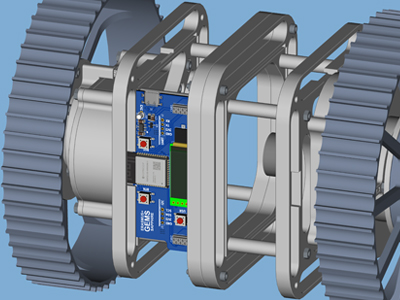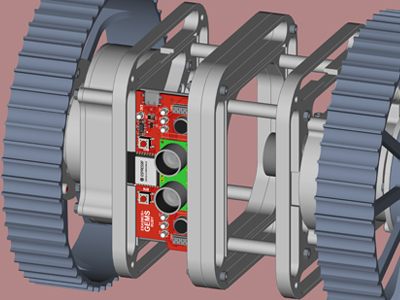Overview
Learn how to integrate components and modules from diverse engineering disciplines into cohesive and functional robotic systems.
Mechatronic systems are transforming our world, with robots as some of the most impactful examples. These versatile machines enhance efficiency across diverse fields, from manufacturing and agriculture to household tasks and space exploration.
Robots highlight the power of mechatronic system integration, where mechanical, electronic, and control systems are seamlessly combined to relieve humans of repetitive or hazardous tasks.
This course provides essential knowledge and practical skills for system integration in mechatronics, with a focus on robotics.
Participants will learn to tackle the challenges of integrating multiple engineering disciplines to design and develop robotic applications. Through hands-on learning activities and real-world examples, you’ll gain the skills needed to conceptualize, build, and control fully integrated mechatronic systems and robots.
Who is this course for?
Designed for engineering students, young engineers or experienced specialists, this course offers an ideal gateway to mastering robotic systems.
A hands-on approach: build your own robot
One of the course's unique features is its use of modular mechatronic educational hardware. This hardware facilitates a systematic approach to designing robotic applications, guiding you through the entire process of mechatronic system integration – from conceptualization and analysis to construction and control.
The open-source hardware and firmware enables customization, making it adaptable for various applications, including student thesis projects.
Full Program
This course is an initiative of the Erasmus + project GEMS (Graceful Equalizing of Mechatronics Students). It is the last course of the online program: Building Robots: From Mechatronic Components to Robotics, developed by GEMS partners, with the University of Ljubljana leading the part about system integration in robotics.
What You'll Learn
- Explain what a mechatronic system is and its design process
- Describe a mechatronic system’s structure to others
- Define and set system specifications and describe their consequences
- Employ 3D printing in mechatronic system design and integration
- Explain the basics of mobile and articulated robots
- Experience the mechatronic system assembly and testing process
- Calculate the kinematics of simple robots
- Create a control program for mechatronic systems
- Apply wired and wireless communication technologies to control a robot
After taking this course, you will be able to:
- Work as an integrator in a multidisciplinary team of specialists
- Systematically approach mechatronic system design projects to understand the system as a whole
- Make design compromises between system specifications and the difficulty of implementation, which significantly influences design success
- Identify further study areas based on newly discovered interests or gaps in knowledge
Details
Course Syllabus
Week 0: Introduction to System Integration for Robotics
Introduction to the course
Participants learn about course requirements, goals and equipment that will be used.
Week 1: Mechatronic system design
Discussion of mechatronic system design.
- system specifications
- design tools and methods
- connection between design and manufacturing technologies
- modular design
Participants learn to set specifications for a mechatronic system and describe it.
Week 2: 3D printing: Enabling robot manufacturing technology
Technology for 3D printing and its role in mechatronic system design is presented with a focus on FDM 3D printing process
- description of a 3D printer
- explanation of the process
- printed part design guidelines
Participants learn to design a part that can be 3D printed with FDM technology.
Week 3: Mobile robot: Differential drive
The concept of mobile robots is introduced and a mobile robot with a differential drive is analyzed.
- Influence of robot design on movement
- forces during movement
- direct and inverse kinematics in 2D
Participants learn to calculate mobile robot kinematics and create a program for its movement.
Week 4: Robotic arm: An articulated robot
The concept of a robotic arm is introduced, and a simple articulated robot is analyzed.
- influence of robot design on movement
- direct and inverse kinematics in 3D
Participants learn to calculate articulated robot kinematics and create a program for its movement.
Project: Create a wirelessly controlled robot
A project for creating a robot is divided into three parts. Participants learn to implement a robotic application from assembly to result sharing.
Week 5: Part 1 – Assemble
A project to create a wirelessly controlled robot based on GEMS servomotor is introduced and the specifics of creating multi-program wireless control system are discussed.
Participants prepare, assemble and test the robot hardware to gain valuable first-hand experience implementing a mechatronic system.
Week 6: Part 2 – Control
Participants first create a program that demonstrates working communication paths between modules and then extend it to enable robot motion to be controlled from a web interface.
Week 7: Part 3 – Improve and share
In the last week participants improve the robot control program by including additional available sensors or user interface. Project results are presented with a short video and technical documentation.
Qualifications
Chartered Engineering Competences
All our online courses and programs have been matched to the competences determined by KIVI’s Competence Structure, a common frame of reference for everyone, across all disciplines, levels and roles.
These competences apply to this course:
- A1: Extend your theoretical knowledge of new and advancing technologies.
- B2: Conduct appropriate research, and undertake design and development of new and creative engineering solutions.
Admission
This is a Massive Open Online Course (MOOC) that runs on edX.
Prerequisites
- Fundamental Electronics
- Programming
Recommended courses from this series:
- Building Robots: Electrical Drives
- Building Robots: Sensors and Data Acquisition
- Building Robots: Communication Protocols and Hardware


